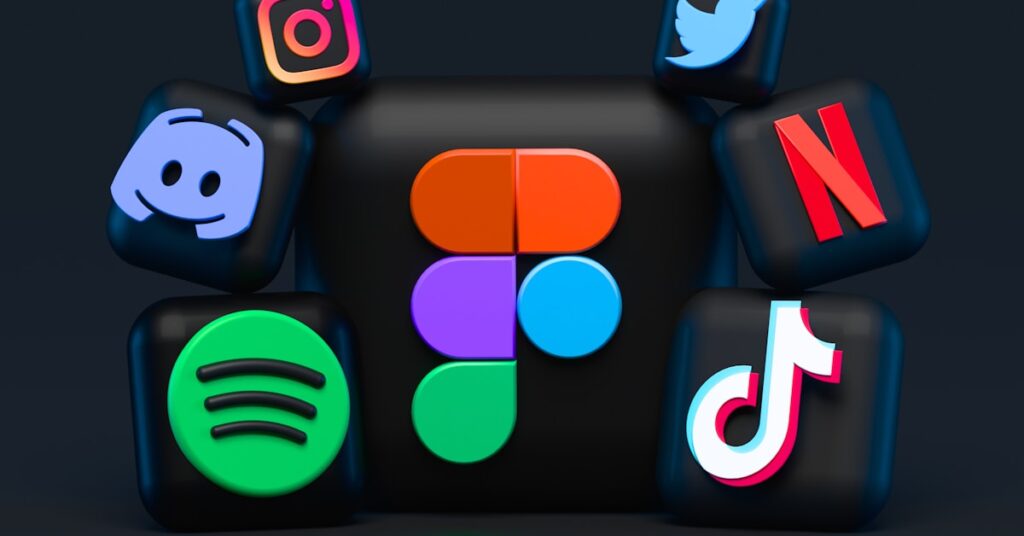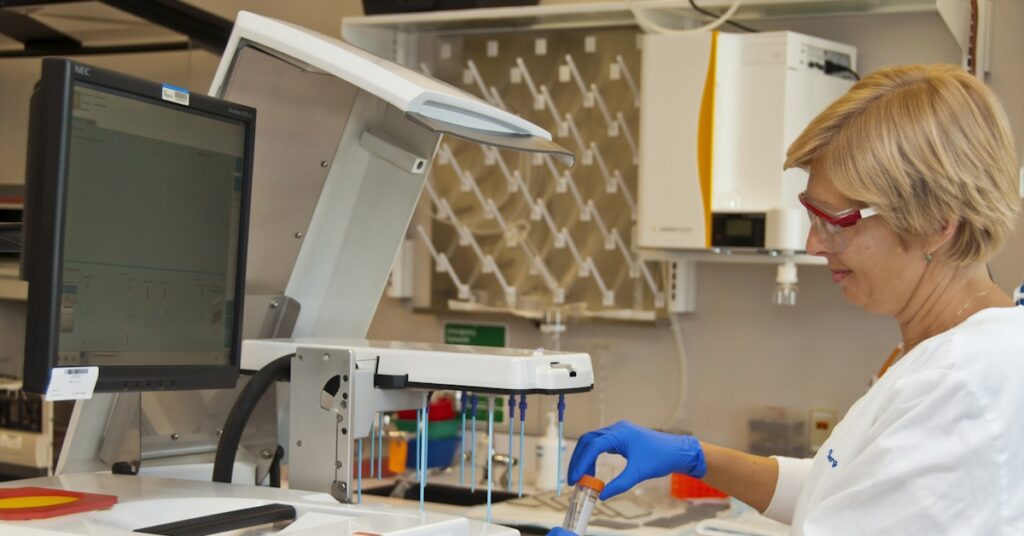Your app design tool is holding you back.
Outdated software and clunky workflows kill your creative momentum, turning simple tasks into a frustrating grind that slows your entire team.
The worst part is that it stifles your team’s innovation, forcing you to compromise on your product vision just to meet deadlines.
This search for efficiency is happening everywhere. Designrush reports that 92% of US developers now use AI coding tools, proving there’s a massive push for smarter, more modern workflows.
The right software can fix this, helping you boost your creative flow and get back to building great apps your users will love.
In this guide, I’ll review the best app design software that streamlines collaboration, simplifies handoffs, and helps your team build and iterate much faster.
You’ll discover solutions that fit your budget, integrate with your current stack, and get your whole team genuinely excited to design again.
Let’s get designing.
Quick Summary:
| # | Software | Rating | Best For |
|---|---|---|---|
| 1 | Figma → | Product managers & UX teams | |
| 2 | Sketch → | Individual designers & teams | |
| 3 | Adobe → | Product managers & UX designers | |
| 4 | Miro → | Product managers & UX teams | |
| 5 | Marvel → | SMBs & prototyping teams |
1. Figma
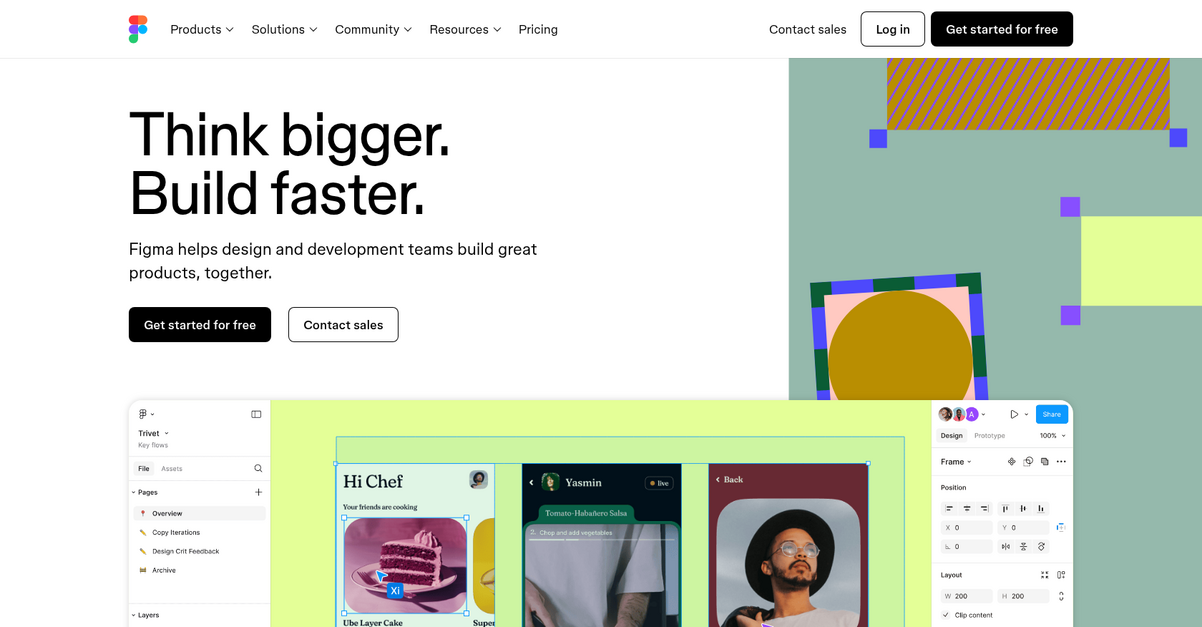
Struggling to balance features with budget and implementation?
Figma Design helps you design and prototype in one shared file, tackling creative workflow restrictions directly.
This means you can explore ideas freely and iterate quickly, generating simple UI with AI to broaden your option space.
It’s time to streamline your product development.
Figma solves this by bringing design and development teams together to build great products, collaboratively.
You can instantly create mockups with AI and design consistently using Auto Layout, so your designs automatically adjust without manual resizing, making prototypes with AI for quick flow testing.
Additionally, Dev Mode provides a dedicated space for developers to translate designs into code, complete with Focus View for inspecting details and design statuses for tracking changes, which builds better products, together. Plus, everyone can collaborate seamlessly in one shared file, communicating via audio, chat, or comments to gather feedback.
Your team can build better products, together.
While focusing on design, understanding product performance is key. My guide on best marketing analytics tools offers insights into measuring success.
Key features:
- Design and Prototype in One Place: Combine your design and prototyping efforts into a single, shared file for efficient iteration and real-time collaboration.
- Dev Mode for Developers: Leverage a dedicated workspace within Figma that simplifies the handoff from design to code, including focus view and design statuses.
- AI-Powered Design Capabilities: Utilize AI features to instantly generate UI mockups and create realistic prototypes for faster testing and broader design exploration.
Figma features, pricing, & alternatives →
Verdict: Figma offers robust collaboration and AI-powered features, making it the best app design software for product managers and UX designers seeking to accelerate product launches and improve user engagement. Its ability to create a single source of truth streamlines workflows and reduces design-to-code handoff friction.
2. Sketch
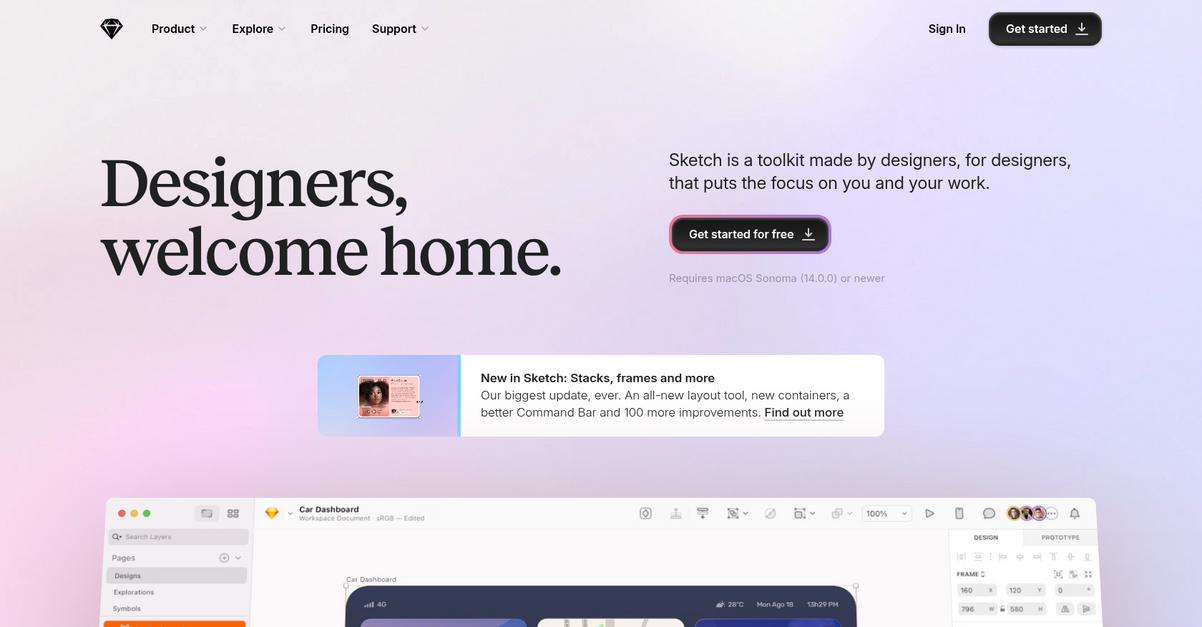
Struggling with app design tools that restrict your creative flow?
Sketch provides a focused toolkit, intuitive interface, and infinite Canvas to help you design without distractions. This means you can concentrate purely on your ideas.
It addresses the pain point of complex software by offering an editor made specifically for designers, not for PMs, developers, or clients. This helps you avoid decision paralysis.
Here’s a better way to design.
Sketch solves these problems by providing flexible foundations like powerful stack layouts and nestable frames that save you time without locking you down. You can also work effortlessly with features like easy multi-layer renaming and a Canvas Minimap.
Additionally, you can create anything from icons to entire apps with their vector editor, and get started fast with hundreds of free templates and component Libraries. Plus, you can even design offline, giving you total freedom.
The result is accelerated product launches and improved user engagement, critical for competitive market positioning, enabling you to test your ideas faster and create realistic prototypes in no time with features like Smart Animate and Overlays.
While we’re discussing design software, you might find my analysis of best architecture design software helpful for other projects.
Key features:
- Focused Design Tools: Provides a distraction-free macOS editor with an infinite Canvas, intuitive interface, and flexible layouts for efficient app design.
- Rapid Prototyping: Allows you to create realistic, interactive prototypes with ease, featuring Smart Animate, Overlays, and multi-directional scroll areas.
- Seamless Collaboration: Supports real-time co-editing, easy sharing with clients, pain-free feedback tools, and shared Workspaces for team-based projects.
Sketch features, pricing, & alternatives →
Verdict: If you’re seeking the best app design software that prioritizes designer workflow and efficient collaboration, Sketch offers a compelling solution. Its focus on intuitive design tools, rapid prototyping, and flexible teamwork features, including free developer handoff, empowers you to ship faster and boost your creative flow, whether working solo or with a team.
3. Adobe
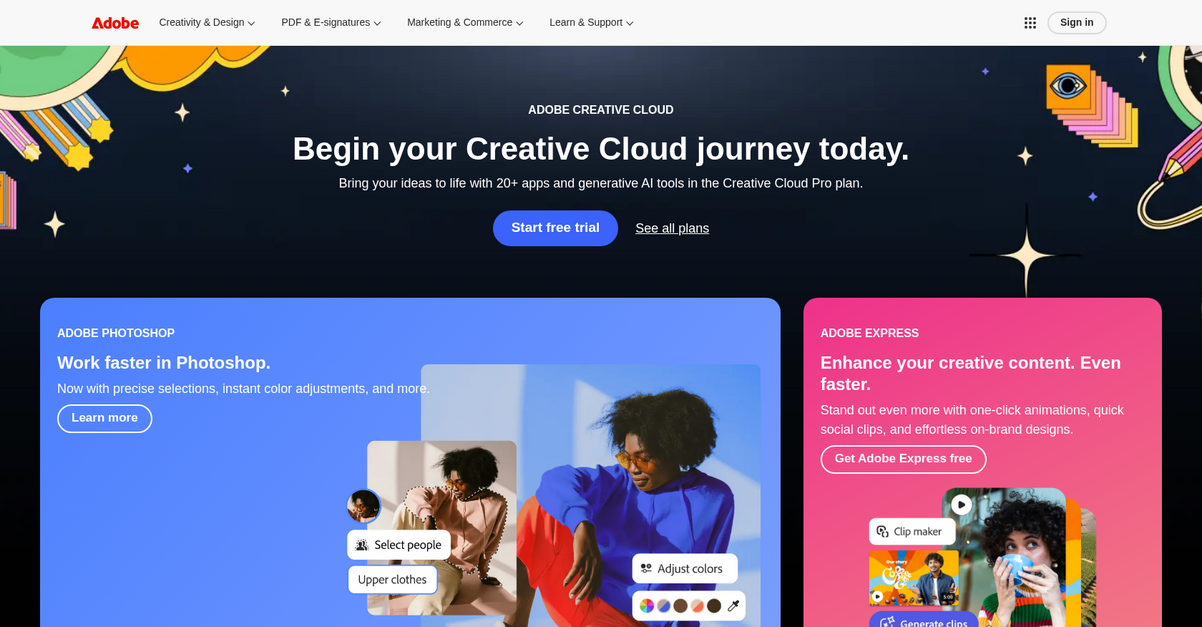
Struggling to bring your app ideas to life?
Adobe offers over 20 apps and generative AI tools, helping you overcome creative restrictions and streamline your workflow.
This means you can accelerate your design process from concept to delivery, addressing the challenge of slow iteration cycles.
Here’s how you can boost your creative flow.
Adobe allows you to bring your ideas to life using a comprehensive suite of tools. This empowers product managers and UX designers to overcome decision paralysis by providing a unified solution.
You can achieve precise selections and instant color adjustments, ensuring your designs are pixel-perfect and on-brand, directly addressing quality concerns. Additionally, with one-click animations and quick social clips, you can enhance your creative content even faster, reducing the time spent on mundane tasks and allowing for rapid experimentation with your app’s visual elements.
The result is accelerated product launches and improved user engagement, essential for maintaining a competitive edge.
Key features:
- Generative AI Tools: Access over 20 apps and generative AI tools to bring your ideas to life, tackling creative bottlenecks and simplifying complex design tasks.
- Photoshop Capabilities: Achieve precise selections and instant color adjustments, ensuring high-quality visuals and streamlined editing for your app designs.
- Adobe Express Enhancements: Create effortless on-brand designs with one-click animations and quick social clips, enabling faster content creation and promotion.
Adobe features, pricing, & alternatives →
Verdict: Adobe is undeniably a strong contender for the Best App Design Software, offering a comprehensive suite of creative tools that address common pain points for product managers and UX designers. Its focus on accelerating creative workflows, enhancing content, and providing precise design control makes it an ideal solution for shipping faster and boosting your team’s creative output.
4. Miro
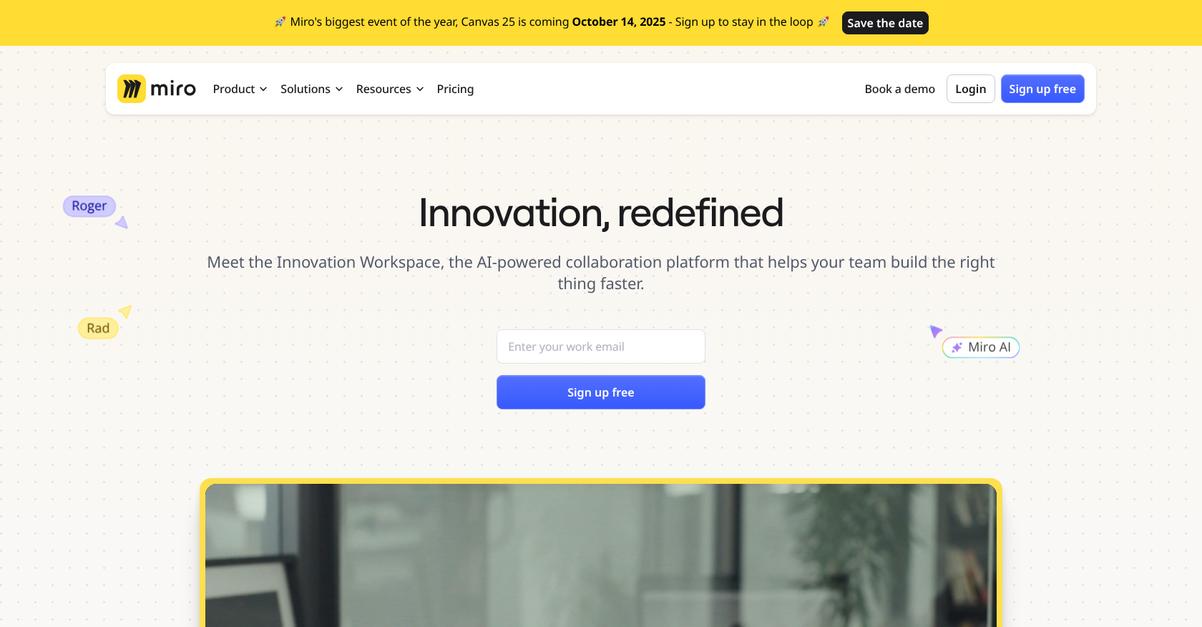
Struggling to translate ideas into exceptional app experiences?
Miro offers an innovation workspace with a limitless canvas, perfect for bringing your initial concepts to life. This means you can create and build together, adding anything from “What if?” moments to the final “Wow!”
The platform’s intelligent canvas helps your team build the right thing faster, moving from first idea to final outcome with greater speed and clarity. This focus on accelerating work is critical when you’re under pressure to deliver.
So, how does it all come together?
Miro provides custom-crafted templates to transform messy brainstorming into super slick workflows, which you can then tweak to fit your team’s specific needs. Additionally, you can maintain your creative flow with distraction-free formats like docs, data tables, and timelines, or even set your preferred default view. The platform also integrates with your favorite planning and productivity tools like Microsoft, Google, and Atlassian, turning solo work into collaborative action. Plus, AI superpowers on the canvas help automate summaries, transform brainstorms into polished diagrams, and create custom shortcuts for repetitive tasks. The result is more time for strategic work and delivering customer value faster.
As you focus on user experience, don’t overlook how online reputation management software can turn customer feedback into a brand advantage.
Key features:
- Limitless canvas: Provides ample space for your team to create, build, and collaborate from the earliest concepts to final outcomes, fostering unrestricted ideation.
- Custom-crafted templates: Offers step-by-step templates to streamline workflows, allowing you to easily organize messy free-for-alls into super slick, customizable processes.
- AI-powered collaboration: Automates routine tasks like summarizing updates, transforms brainstorms into polished diagrams, and creates custom shortcuts for repetitive actions, accelerating your work.
Miro features, pricing, & alternatives →
Verdict: For product managers and UX designers aiming to boost creative flow and ship faster, Miro stands out as a strong contender for the best app design software. Its intelligent canvas, custom templates, and AI-powered collaboration features directly address the pain points of balancing creativity with efficiency, helping your team accelerate product launches.
5. Marvel
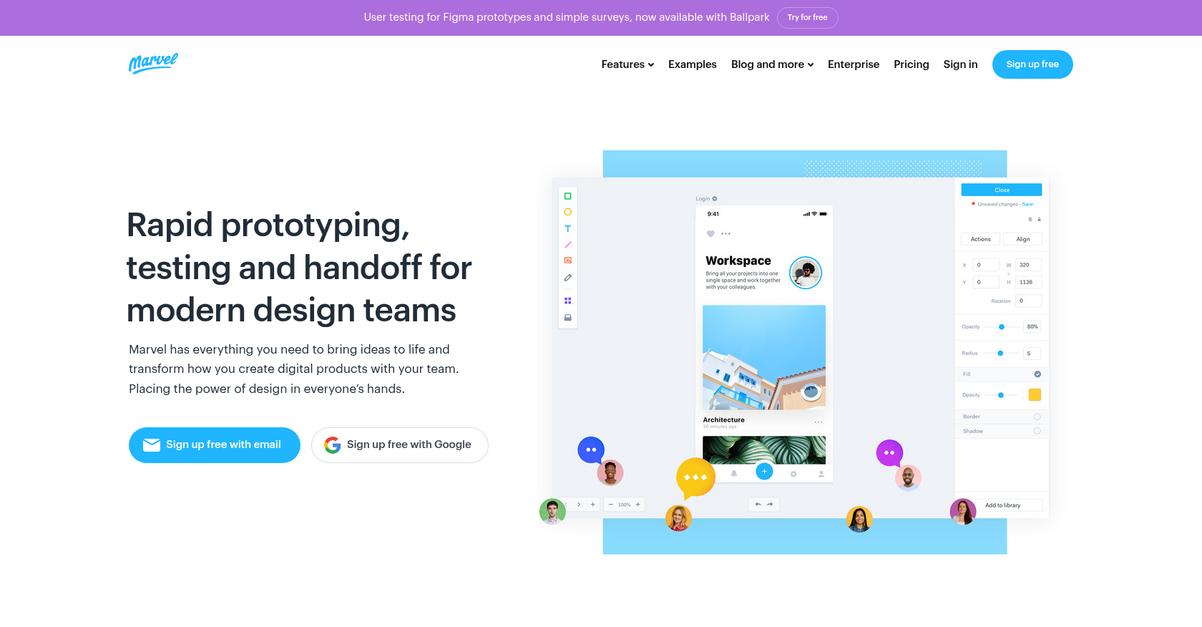
Struggling with slow design workflows and endless revisions?
Your team can transform how you create digital products, from wireframing to interactive mockups. This allows you to bring your ideas to life quickly and efficiently.
With Marvel, you can prototype, test, and handoff designs with unprecedented speed, making design accessible to everyone on your team. This means your projects move faster.
Seamlessly design, prototype, and test.
You can streamline your entire app design process in one intuitive platform. Marvel provides tools for wireframing, designing, and rapid prototyping that adapt to your fidelity needs.
Plus, you can validate your designs at speed with user testing capabilities, helping you gather crucial feedback early. Marvel automatically generates design specs, eliminating manual handoff hassles for developers. Additionally, it integrates with your favorite tools, ensuring a powerful and connected workflow that supports your existing ecosystem.
This comprehensive approach allows you to iterate faster, reduce friction between design and development, and ensure your final product aligns perfectly with user expectations. The result? Faster launches and improved user engagement.
While focusing on app design, you might also find my guide on best PCB design software useful for other hardware-related projects.
Key features:
- Prototyping & Design: Create interactive mockups and full designs, from low to high-fidelity, enabling rapid ideation and visualization of your app concepts.
- User Testing & Validation: Validate designs quickly with built-in user testing features, allowing you to gather essential feedback and iterate efficiently.
- Developer Handoff & Integrations: Automatically generate design specifications for developers and integrate with your existing workflow tools to power up your productivity.
Marvel features, pricing, & alternatives →
Verdict: Marvel stands out as a strong contender for the best app design software, particularly for SMBs seeking a unified solution. Its focus on rapid prototyping, user testing, and automated developer handoff addresses core pain points like slow workflows and manual processes, enabling teams to ideate fast and optimize prototypes before development.
6. Axure
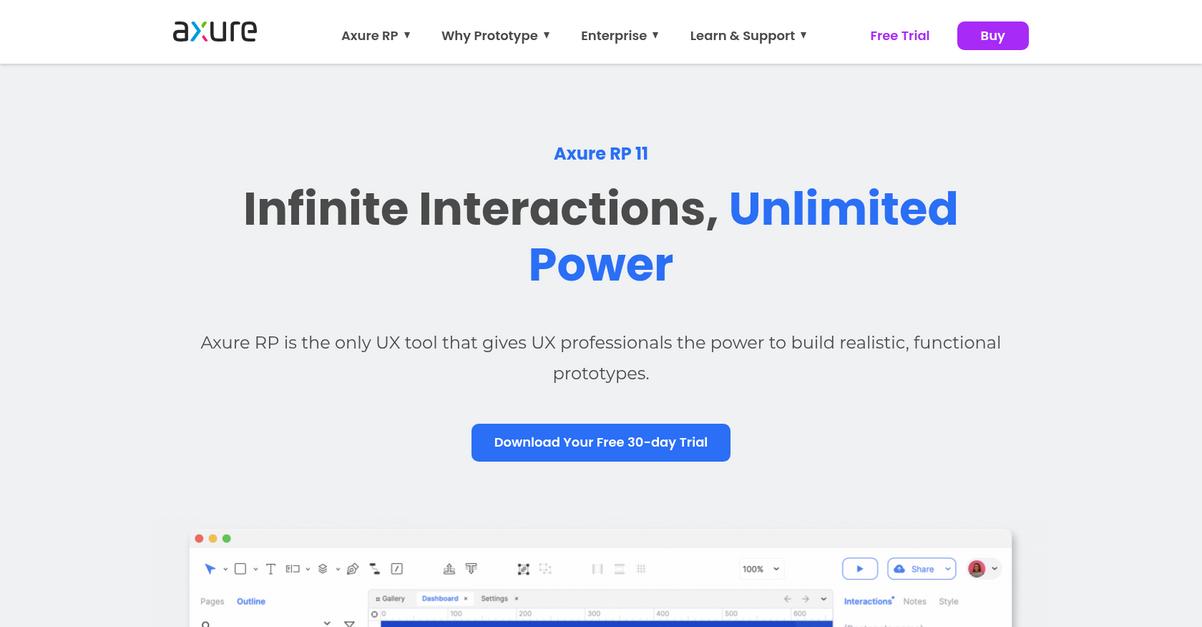
Struggling with complex app designs and real-time collaboration?
Axure RP helps you build realistic, functional prototypes with unlimited interactive possibilities. This means you can truly explore digital experiences without coding.
You can leverage powerful widgets to create working forms, sortable grids, and dynamic interfaces, making realistic, functional UX prototypes easier than ever.
Here’s how Axure empowers you.
Axure allows you to create prototypes with unlimited combinations of event triggers, conditions, and actions. This gives you the power to explore every interactive possibility.
You can also use working forms with text fields and radio buttons or multi-state containers to build scrollable screens and popups. Plus, you can create data-driven tables that dynamically sort and filter using the repeater widget, and design for all devices from a single page.
Additionally, Axure offers comprehensive tools for UX professionals to create diagrams, customer journeys, and wireframes alongside your prototypes. You can even add notes and specifications for developers, and easily publish to Axure Cloud for feedback, streamlining handoff with automated redlines and CSS inspection.
The result is higher quality user feedback.
Before diving deeper, you might find my analysis of Amazon seller tools helpful.
Key features:
- Realistic Prototyping: Build functional prototypes with infinite interactions using events, conditional logic, and dynamic content without writing any code.
- Comprehensive Documentation: Create diagrams, customer journeys, wireframes, and add detailed notes and specifications for developers and stakeholders directly within the tool.
- Seamless Collaboration: Share functional prototypes via Axure Cloud, gather on-screen feedback, and integrate with Slack, Microsoft Teams, Jira, Confluence, Figma, Adobe XD, and Sketch.
Axure features, pricing, & alternatives →
Verdict: Axure RP is a powerful contender for the best app design software, particularly for product managers and UX designers seeking comprehensive prototyping capabilities without code. Its ability to create interactive experiences and integrate with existing workflows like Jira and Figma addresses key pain points around complexity and collaboration.
7. Balsamiq
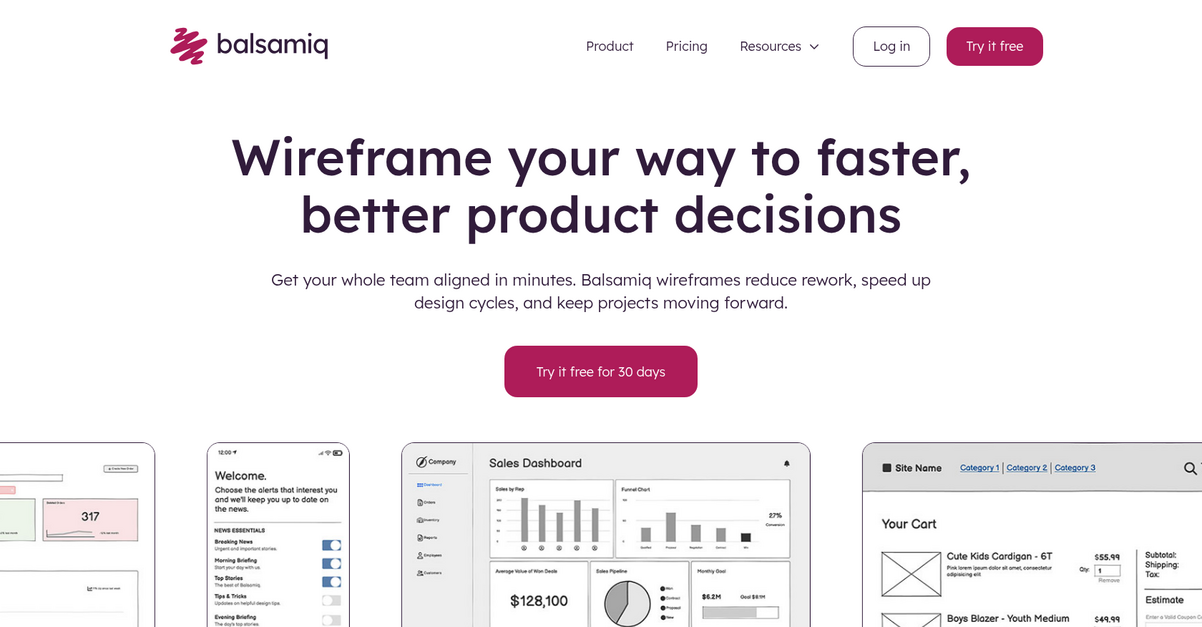
Is your team struggling with design alignment?
Balsamiq’s wireframing capability quickly gets your whole team aligned, reducing rework and speeding up design cycles. This means you can keep projects moving forward efficiently.
You can easily drag and drop to get ideas down in minutes, avoiding steep learning curves or lengthy requirements documents that often slow you down.
No more getting lost in translation.
This software helps you create quick wireframes using pre-built UI components, which you can customize or start with a template. You can then share your work via a link or by exporting, ensuring everyone, from product managers to engineers, understands your vision. This shared visual language eliminates guesswork from documents. The low-fidelity design keeps conversations focused on flow and function, preventing premature debates over small details like colors or pixels, ultimately saving your team wasted meeting and build time.
You’ll see immediate progress.
While we’re discussing design and user experience, understanding how to leverage user generated content platforms can boost engagement.
Key features:
- Quick Wireframe Creation: Drag and drop UI components allow you to generate ideas rapidly, streamlining initial design concepts without technical hassle.
- Effortless Sharing & Collaboration: Easily share wireframes via links or exports, fostering clear communication and quick feedback to align your team efficiently.
- Focus on Core Functionality: The low-fidelity design intentionally keeps discussions centered on flow and user experience, preventing distractions from minor visual details.
Balsamiq features, pricing, & alternatives →
Verdict: If you’re a product manager or UX designer seeking the Best App Design Software to accelerate product decisions and team alignment, Balsamiq is an excellent choice. It emphasizes low-fidelity wireframing to foster efficient collaboration, reducing rework and ensuring your team focuses on core functionality, as highlighted by many users who praise its simplicity and effectiveness.
8. Proto.io
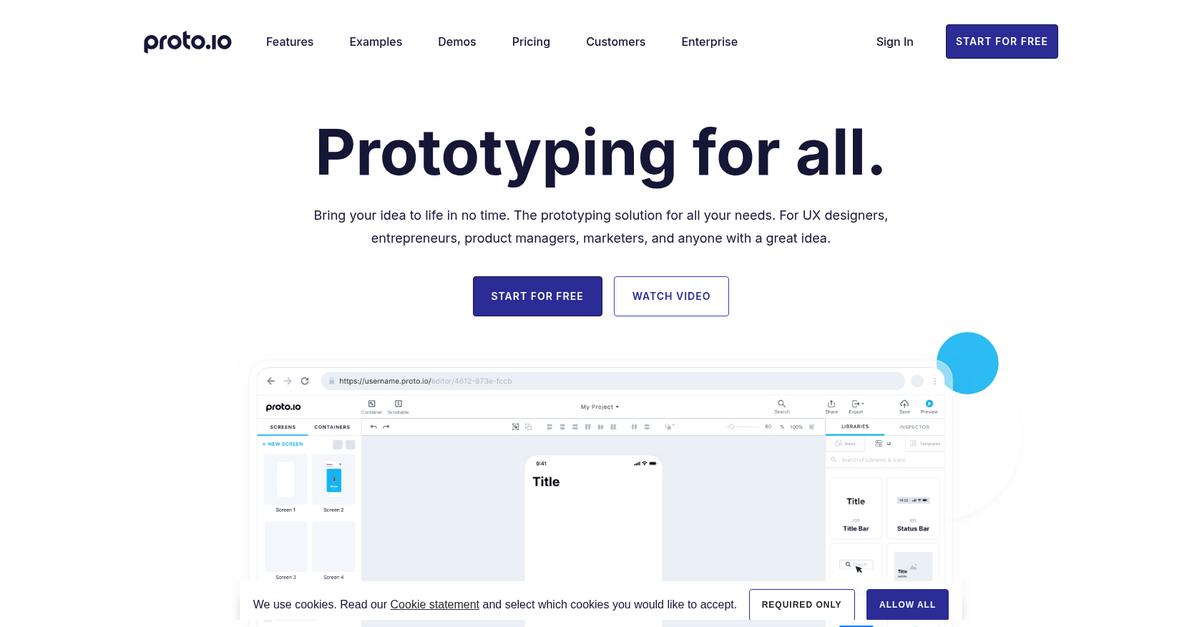
Struggling to bring your app ideas to life?
Proto.io offers an intuitive, drag & drop interface with 250+ UI components and 1000+ templates. This means you don’t need any coding skills or to start building your first prototype from scratch. Your team can jump right in.
Proto.io solves the common headache of complex implementation and restricted creative workflows.
This is how you bring your design vision to life.
Proto.io allows you to add different levels of interactivity, making your simple wireframe feel like a real product. You can utilize over 80 events and 40 actions to create limitless interactions, including nested and multidirectional scrollable areas.
Additionally, Proto.io takes your prototype’s interactivity further with powerful animation features. You can connect screens with 18 smooth transitions, and use timeline-based state animations to control timing, easing, and duration for any layer. Plus, apply animation effects, filters, and shadows to change opacity, colors, fonts, and more, giving motion to your design without limits. The result is a prototype that truly communicates its intended functionality.
Your team can preview, share, and get feedback effortlessly.
If you’re also exploring how to create dynamic visual experiences, my article on best digital signage software offers valuable insights.
Key features:
- Intuitive Drag & Drop Interface: Start building your prototype instantly with no coding or design skills required, using a user-friendly drag & drop interface.
- Rich UI Components & Templates: Leverage over 250 UI components that mimic native behavior and 1000+ ready-made templates for web and mobile.
- Advanced Interactivity & Animations: Add life to your designs with over 80 events, 40 actions, nested scrollable areas, and powerful animation features like screen and timeline transitions.
Proto.io features, pricing, & alternatives →
Verdict: If you’re a product manager or UX designer looking for the best app design software, Proto.io delivers powerful prototyping capabilities that significantly reduce design-to-code friction. Its intuitive no-code approach, rich asset libraries, and advanced animation features allow you to bring realistic prototypes to life quickly and secure client buy-in, as seen with their customer success stories.
9. UXPin
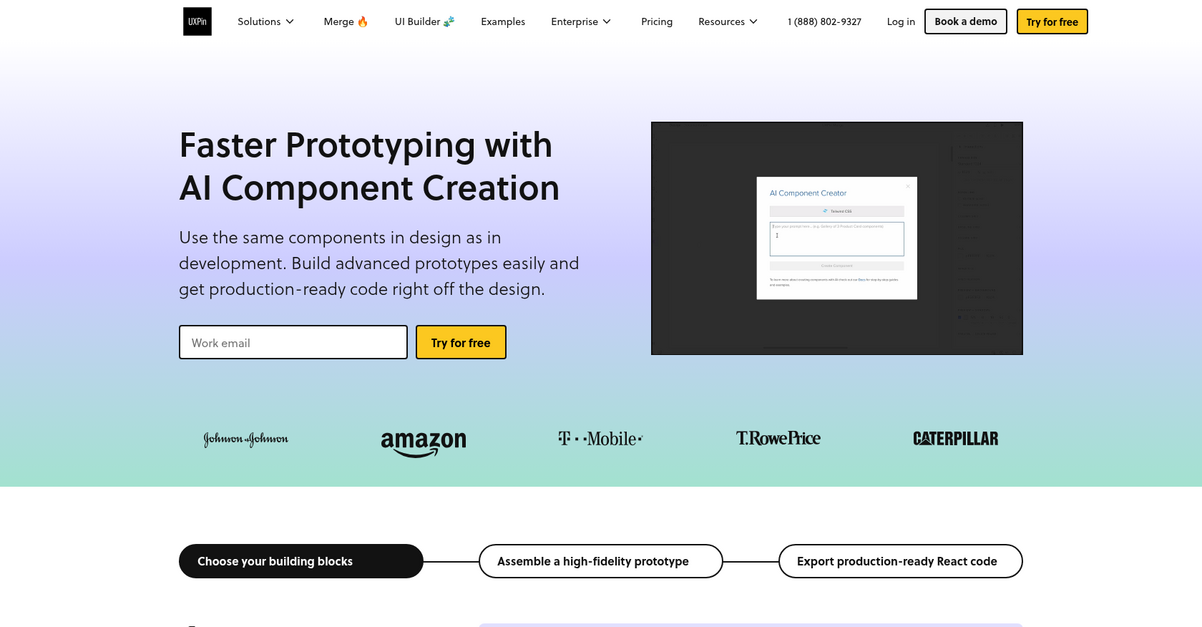
Struggling to align design and development teams effectively?
UXPin helps bridge this gap by letting you design UI with code-backed components, making your designs production-ready.
This means you can use the same components in design as in development, drastically reducing handoff headaches and accelerating your timelines.
Ready to ship products faster?
UXPin solves your challenges by building advanced prototypes easily and exporting clean, production-ready React code. You can use built-in coded libraries like MUI and Tailwind UI, or sync your own Git component repository.
This integration streamlines the entire design-to-development process, enhancing productivity, quality, and consistency, as experienced by Sr. UX Designer Brian Demchak at AAA Digital & Creative Services. Plus, you can breathe life into your prototypes with advanced interactions, variables, and conditional logic, making them behave exactly like the end product.
The result: a single environment for everyone.
If you’re evaluating other business software, my article on Best Dealer Management System covers essential tools for growth.
Key features:
- Code-backed components: Design with real, production-ready code components from libraries like MUI or your own Git repo, ensuring consistency between design and development.
- Advanced prototyping: Create fully functional, high-fidelity prototypes with variables, conditional logic, and AI Component Creator, reducing the time to gather feedback.
- Streamlined handoff: Export clean React code and specs directly from your designs, accelerating development timelines and saving engineering time by around 50%.
UXPin features, pricing, & alternatives →
Verdict: If you’re seeking the best app design software that integrates design with development, UXPin is a powerhouse. Its ability to use code-backed components and export production-ready React code directly from prototypes accelerates product launches and significantly reduces engineering time, as reported by users like Larry Sawyer.
Conclusion
Is your design process too slow?
I get it. Choosing from a saturated market is paralyzing, and a bad choice means clunky workflows and missed deadlines for your startup.
Gartner forecasts that 70% of new applications will use low-code tech by 2025 to ship faster. This shift makes efficient tooling a competitive necessity, not just a preference.
Here is what I strongly recommend.
After reviewing dozens of tools, Figma is the clear winner. It directly solves collaboration bottlenecks that restrict creative flow and slow down developer handoffs.
Its AI features and Dev Mode create a single source of truth for the entire team. This is what the best app design software should do for you.
As you build and grow your startup, understanding your business’s value is crucial. My analysis of best business valuation software can help you accelerate that process.
I encourage you to get started for free with Figma and see how it unifies your design and development workflows.
You’ll boost your creative flow instantly.
